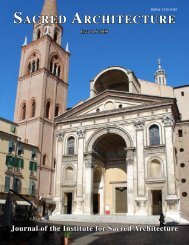Download Issue PDF - The Institute for Sacred Architecture
Download Issue PDF - The Institute for Sacred Architecture
Download Issue PDF - The Institute for Sacred Architecture
- No tags were found...
You also want an ePaper? Increase the reach of your titles
YUMPU automatically turns print PDFs into web optimized ePapers that Google loves.
CATHOLIC IDENTITY, THE BUILDING, THE REACTIONSA VIEWPOINT FROM ANTHROPOLOGYRev. William J. TurnerA R T I C L E SIt has become evident recently that aplethora of opinions and reactions to liturgicalrenewal exist, especially as it appliesto sacred space. This fact is reflectiveof the concern of many Catholics, and itneeds to be seriously addressed.Today, an evergreaternumber ofCatholic laity are welleducatedprofessionalswho expect that an approachto renewal willreflect a more collaborativemethod of decisionmaking.A model <strong>for</strong> renewalthat does not includelistening to theirconcerns will often meetwith rejection. I suggestthat proposals <strong>for</strong> renewalneed to be testedin the light of the experienceof Catholics as wellas by the teaching of theChurch. If so, renewalwill become acceptableto such individuals,rather than becoming achallenge to their identity.<strong>The</strong>ir history andtheir culture would thusbe respected and upheldas valuable.An understanding ofthe anthropological processof critical self-reflectionbecomes an importantelement here. Criticalself-reflection demandsthat an observerrethink categories andreorient perspectivesthat involve the effectsof the liturgical renewal.It is interesting tonote that when the Center<strong>for</strong> Pastoral Liturgyat Notre Dame celebratedits 25th Anniversaryin 1995, even liturgists felt that thefirst among significant losses in the last 25years of renewal was “Catholic identity.”<strong>The</strong> question may arise whether traditionalsymbols found in our church buildingsmay be changed. My respondentshave seemed to accept many of their symbolsas having eternal value that rise from acommunity history. <strong>The</strong>y often report thatany new symbols proposed must respectthe older symbols.My research has encouraged many responsesfrom Catholics. In the light of reflectionupon this experience of commentsSt. Mary of All Angels, Chicago, Illinoisand concerns, I offer recommendations thatmay enhance successful implementation ofrenewal or refurbishing processes. Onemay wish to reflect upon the following:What is the Catholic identity of thisgroup of people? On what do they focusupon entering their church building? Dothey look <strong>for</strong> symbols that express “Catholicism”<strong>for</strong> them? A strong Eucharisticpresence and Eucharistic sensibility may benoted. This concept is not unanimously acceptedas primary, yet it is nonetheless acritical element of Catholic identity. Ideas<strong>for</strong> construction or renovation seem to beappreciated by these individualswhen theyhave been applied withconsideration <strong>for</strong> theirlocal parishes, ratherthan being applied asuniversal concepts. (Forexample, a baptismalpool may not be appropriateto every parish,and indeed may be offensiveto some parishioners.This sensibilitycould change in the future.)Does the proposedrenovation exhibit a respect<strong>for</strong> the history andexperience of this groupof people? It would bedifficult to respond tothis if an architect or artistwere not willing orable to spend time in acommunity and begin toknow these people inmany contexts. <strong>The</strong>irhistory can be celebratedin many waysthat can bring aboutfeelings of trust ratherthan suspicion.What is the history ofthe parishioners’ relationshipwith leadershipin the parish? Whatmodels have been used?If the community hashad a negative relationshipwith its leadership,there may be a hesitancyto express trust in newproposals. Healing canoccur if the leadership iswilling to listen without an agenda of proposedchanges.How does a proposal <strong>for</strong> change effectthe concept of the church seen as “thehouse of God” apart from its use as “thehouse of worship?” This is a key distinction.<strong>The</strong> building is their sacred building,home to sacred things, and not just an edifice<strong>for</strong> sacred events and ceremonies, and<strong>Sacred</strong><strong>Architecture</strong> Fall 2000 27










